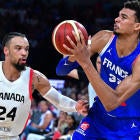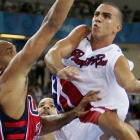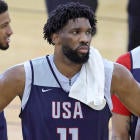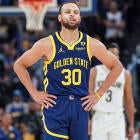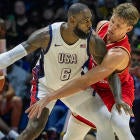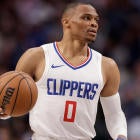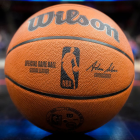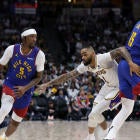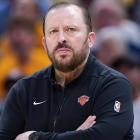Ben Simmons had, before Thursday, declined to meet with, or workout for, the Sixers, which had some criticizing the former LSU standout. But I actually thought it was a sensible decision, and here's why: Simmons, reportedly, would prefer to go second to the Lakers than first to the Sixers. And refusing to meet with, or workout for, the Sixers would've increased, to a debatable degree, the odds of that happening.
Either way, what was the worst thing that could come from Simmons ignoring Philly?
Answer: Philadelphia would still select him first overall.
So Simmons' chosen course of action would've either led to him getting what he wants... or... led to him being the first overall pick in the 2016 NBA Draft. There is no third option. And that's why it's silly to criticize the Australian phenom who could develop into the face of a franchise. At best, he gets what he wants and goes to the Lakers. At worst, he's the first pick. Two good options. No bad ones.
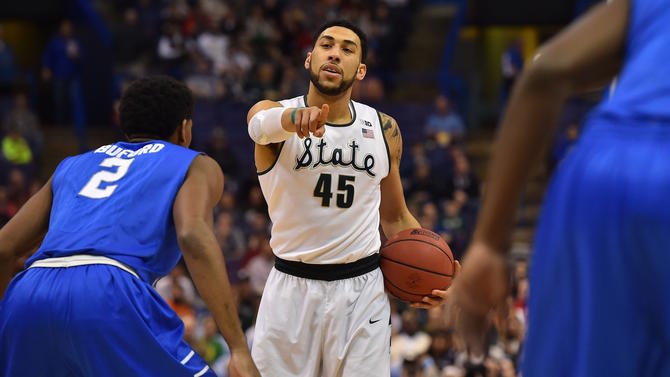
NBA Mock Draft
| 1. Philadelphia 76ers | |
 | Ben Simmons, SF, LSU: If the Sixers truly believe Simmons will emerge as the best prospect from this draft -- and, by most accounts, they do -- then they should select Simmons no matter what because when franchises cave to a prospect's wishes, it's almost always a mistake. (Remember when John Calipari's Nets got bullied and scared and passed on Kobe Bryant?) So I still expect the one-and-done phenom from LSU to go first overall even if he'd rather go second overall. |
| 2. Los Angeles Lakers | |
 | Brandon Ingram, SF, Duke: Los Angeles, like Philadelphia, would prefer Simmons, I'm told. But getting Ingram is still a great outcome for the post-Kobe Lakers. He's a long athlete who shot 41 percent from 3-point range in one season at Duke. I can't promise he's the next Kevin Durant. But when you watch him, it's easy to see why those comparisons exist. Ingram would fit perfectly with the Lakers' young core. He could be the player who helps return the franchise to respectability. |
| 3. Boston Celtics | |
 | Jamal Murray, SG, Kentucky: Murray made 79 of 100 3-point attempts during a recent workout with the Celtics. It was a performance that suggests there's nothing fluky about the 40.8 percent he shot from 3-point range during his one season at Kentucky. Meantime, Boston really needs shooting. And I just can't imagine a scenario where Murray isn't a good NBA scorer. So the Celtics going this direction -- if they keep they pick, which is undetermined -- makes a lot of sense on multiple levels. |
| 4. Phoenix Suns | |
 | Dragan Bender, PF, Israel: Bender is widely regarded as the top draft-eligible prospect who didn't play college basketball this season, and there's little doubt he'll be selected in the top half of the lottery. He's an 18-year-old forward who should develop into a nice stretch-four at the NBA level. Boston, to be clear, has scouted him extensively and could take him third overall. But if the Celtics pass, the Suns probably won't. |
| 5. Minnesota Timberwolves | |
 | Buddy Hield, SG, Oklahoma: Minnesota coach Tom Thibodeau accurately believes the Timberwolves are ready to break through and make the NBA Playoffs soon. So drafting someone who can contribute immediately makes sense, and Hield is undeniably ready to play as a rookie. The reigning CBS Sports National Player of the Year is probably the best shooter in this draft, meaning he'd be a great addition to a Minnesota team that ranked 25th in 3-point shooting this season while finishing 29-53. |
| 6. New Orleans Pelicans | |
 | Kris Dunn, PG, Providence: Anthony Davis has played four seasons in New Orleans. He's missed the playoffs three times. He's still never won a postseason game. So the Pelicans need to use this pick to get him somebody who can contribute immediately, and Dunn is that somebody. The point guard might be the best plug-and-play prospect in this draft. He could start on opening night if the Pelicans need him to start on opening night. |
| 7. Denver Nuggets | |
 | Marquese Chriss, PF, Washington: Chriss' rise up draft boards is historic in the sense that he could, and likely will, become the first one-and-done prospect to be selected in the top 10 after not being ranked in the top 50 of his high school class. He's not yet as polished as some other prospects because he hasn't been playing organized basketball as long as most others. But Chriss has a higher ceiling than almost anyone in this draft. That seems to be a consensus opinion. |
| 8. Sacramento Kings | |
 | Jaylen Brown, SG, California: Brown is a top-shelf athlete and possible top-five pick. But he's the one guy in this range that everybody seems intrigued by but few love. Why didn't he close more strongly at Cal? Is he coachable or a young guy who thinks he already has all the answers? These are questions scouts are asking, I'm told. But, at some point in the top 10, somebody will take Brown simply because he's a big wing who can play the four in a small-ball lineup, and big wings who can play the four in small-ball lineups are more valuable than ever in the NBA. |
| 9. Toronto Raptors | |
 | Henry Ellenson, PF-C, Marquette: Toronto has a need at power forward, which makes Ellenson an option. The one-and-done prospect is only 19. And though he didn't shoot a good percentage from beyond the arc at Marquette, he has the tools to be a stretch-four. Combine that with his polished low-post game, and Ellenson has one of the highest ceilings in this draft. |
| 10. Milwaukee Bucks | |
 | Jakob Poeltl, PF, Utah: The Bucks would like to see Ellenson fall, which would allow them to draft a potential stretch-four who played college ball in Milwaukee. But if he's off the board, Poeltl is a good fit. He's a big who plays big -- proof being that 94 percent of his buckets this past season came around the rim. The 7-foot-1 center would help Milwaukee shore up an interior defense by adding a rim protector who is a good-enough athlete. |
| 11. Orlando Magic | |
 | Skal Labissiere, PF, Kentucky: Frank Vogel's ability to develop young talent should be instrumental in a predicted turn for the better in Orlando. And if I'm the Magic, I'm taking one of the many young forwards with lots of potential and asking Vogel to do for them what he just did for Myles Turner with the Pacers. Labissiere, if available, would be among the interesting options. Once considered a possible top overall selection, he mostly struggled in his one season at Kentucky. But the possibility for greatness is still there and intriguing. So he's worth a gamble somewhere in the lottery of a weak draft. |
| 12. Utah Jazz | |
 | Timothe Luwawu, SG, France: Luwawu is a wing who has good size and is an above-average athlete and defender. Those things alone would get him selected in the first round, probably. But the fact that he also shoots about 40 percent from 3-point range makes him a possible lottery pick and nice option for the Jazz even with Rodney Hood and Gordon Hayward on the roster. |
| 13. Phoenix Suns | |
 | Deyonta Davis, PF, Michigan State: The Suns have three first-round picks. So they can afford a big swing here. And Davis qualifies as such. He declined to test athletically at the combine and will likely need to perform well in private workouts to ensure a place in the lottery. But the 6-11 forward showed himself as a high-level rebounder in limited minutes during his one season at Michigan State, and he was also one of the nation's best shot-blockers. So, at worst, Davis should be a difference-maker on the defensive end at the NBA level. |
| 14. Chicago Bulls | |
 | Domantas Sabonis, PF, Gonzaga: A report that Joakim Noah is leaving Chicago via free agency suggests the Bulls could focus on frontcourt prospects -- and Sabonis would be one who could play right away. He skipped the combine completely, which caused some to suggest Sabonis might've received a promise somewhere in the top 20. Whether that's true or not remains unclear. But he would make sense for Chicago, especially if Noah is leaving. |
| 15. Denver Nuggets | |
 | Furkan Korkmaz, SG, Turkey: Korkmaz is a terrific shooter with ideal size for his position, and the fact that he decided to remain in the NBA Draft suggests he has a promise somewhere in the top 20. For a team that needs depth everywhere and shooting -- the Nuggets tied for 25th in 3-point shooting this regular season -- Korkmaz is a smart option. |
| 16. Boston Celtics | |
 | Ante Zizic, C, Croatia: The Celtics have so many picks that they're going to need to either package them for a player or select multiple international players that can theoretically be stashed. So a prospect like Zizic -- who has been impressive this season while leading the Adriatic League in rebounding -- is a real possibility. |
| 17. Memphis Grizzlies | |
 | Wade Baldwin IV, SG, Vanderbilt: The Grizzlies need help at point guard -- preferably in the form of somebody who A) is big enough to sometimes play next to Mike Conley, and B) can shoot from the perimeter. Baldwin checks both boxes. And the fact that he measured and tested well at the combine basically guarantees some franchise will take him in the first round. |
| 18. Detroit Pistons | |
 | Malachi Richardson, SG, Syracuse: Richardson has parlayed a nice performance in the NCAA Tournament into a likely guaranteed contract, which is something few saw coming in, say, February. The 6-6 guard is a good athlete who measured and tested well at the combine. Not everybody likes him. But he has enough fans in franchises to secure a spot in the first round -- perhaps even a spot late in the lottery. |
| 19. Denver Nuggets | |
 | Ivica Zubac, C, Croatia: The Nuggets have three first-round picks but do not need three rookies on their roster. So a draft-and-stash seems likely. And Zubac is a terrific candidate for such given that he's only 19 years old and maybe willing to stay in Serbia for another year. He's averaging double-figures in Europe for a team that could have multiple draft picks. |
| 20. Indiana Pacers | |
 | Brice Johnson, PF, North Carolina: Johnson was a monster while averaging 16.6 points and 10.6 rebounds and leading North Carolina to the national championship game. The quick leaper improved his stock enough to where going in the top 20 of this draft isn't out of the question. And for the Pacers, he would provide needed frontcourt depth. |
| 21. Atlanta Hawks | |
 | Taurean Prince, SF, Baylor: This 6-8 wing has the athleticism and wingspan to guard his position, and even multiple positions, at the NBA level. I know some teams in the teens like him. So there's no guarantee Prince will be available at 21. But, if he is, the Hawks would be wise to snatch him up. |
| 22. Charlotte Hornets | |
 | Denzel Valentine, SG, Michigan State: Valentine reportedly has a "fairly significant knee issue" that is causing concern with some teams, and, I'm told, it could cost him on draft night. Without that issue, he could go in the top 10. But there's no guarantee he'll even go in the teens with it. At some point, somebody, will weigh the risk vs. the reward and snag the former Michigan State star. But, at this point, it's hard to pin things down. |
| 23. Boston Celtics | |
 | Thon Maker, C, Australia: Maker is still mostly an unknown in the sense that he's never played basketball consistently against high-level competition. But he measured, tested and interviewed well at the combine, where he gained lots of fans. And now it seems more likely than not that Maker will go in the first round based on little more than the idea that his ceiling is higher than most prospects' ceilings. |
| 24. Philadelphia 76ers | |
 | DeAndre' Bembry, SF, Saint Joseph's: Bembry was, by all accounts, terrific at the combine. He tested well and played magnificently in the five-on-five games. His ability to guard multiple positions at the NBA level should prove useful, and the way Bembry sees the floor and passes could allow him to, at times, play the role of point-forward, which Philadelphia's front office should know well considering Bembry played down the street at St. Joe's. |
| 25. Los Angeles Clippers | |
 | Demetrius Jackson, PG, Notre Dame: Jackson tested and interviewed well at the combine and will be the second straight Notre Dame guard to go in the first round. His ability to flourish in the pick-and-roll while being a respectable shooter -- he shot better than 41 percent form 3-point range in his freshman and sophomore years -- should allow him to become an NBA starter. But he'll begin his career as a back-up PG, which is something the Clippers could use. |
| 26. Philadelphia 76ers | |
 | Tyler Ulis, PG, Kentucky: Ulis reportedly has a "pretty significant hip issue" that when combined with his lack of size could cause him to slip even into the second round on draft night. Like Valentine, it's impossible to say exactly where the reigning SEC Player of the Year will land. But somebody is really going to have to like him to spend a high pick on a tiny guard with a hip problem. |
| 27. Toronto Raptors | |
 | Diamond Stone, C, Maryland: Stone has not helped himself in interviews, I'm told. And there are background issues that concern some franchises. Still, he's just so much more talented than most other prospects in this range. And that's why the Raptors might be willing to take a swing late in the first and hope the talent develops, and the other concerns disappear, with time. |
| 28. Phoenix Suns | |
 | Juan Hernangomez, PF, Spain: The Suns do not need three players on rookie contracts. So they could go with a draft-and-stash prospect here. Hernangomez qualifies as a great option. He's a 6-9 stretch-4 who shot roughly 40 percent from 3-point range in Spain. |
| 29. San Antonio Spurs | |
 | Cheick Diallo, C, Kansas: Diallo measured and tested well at the combine -- then played well in the five-on-five games. He was active. He rebounded. He guarded. Simply put, the 6-9 forward genuinely helped himself by reminding scouts why he was once a projected lottery pick. And now it looks like that subpar season at Kansas won't cost Diallo too much money. And he'd be a great fit with San Antonio, which needs and athletic big. |
| 30. Golden State Warriors | |
 | Ben Bentil, PF, Providence: Bentil is a long and athletic forward who can score from multiple spots -- around the rim and all the way out to the 3-point line. He was terrific this season at Providence, and he played well in the five-on-five games at the combine. Given how much Golden State asks players to be versatile -- and how much Steve Kerr likes his team to shoot from the perimeter from four positions -- Bentil would make a lot of sense in a Warriors uniform. |
| Round 2 | |
| 31. Boston Celtics (from PHI via MIA) | |
 | Zhou Qi, C, China: The Celtics are probably going to select multiple international prospects that they can leave overseas considering the amount of picks they possess. Qi would be the best available here |
| 32. Los Angeles Lakers | |
 | Stephen Zimmerman Jr., C, UNLV: Zimmerman is a one-and-done prospect who is a former top-10 recruit. He's worth a flyer in the second round. |
| 33. Los Angeles Clippers (from BKN) | |
 | Patrick McCaw, SG, UNLV: McCaw is a long backcourt prospect who will be able to guard multiple positions in the NBA. He averaged 14.7 points, 5.1 rebounds, 3.9 assists and 2.5 steals this past season at UNLV. |
| 34. Phoenix Suns | |
 | Dejounte Murray, PG, Washington: Murray's upside makes him a gamble worth taking maybe in the first round, and definitely somewhere early in the second. The athleticism and size are there even if the actual basketball skills aren't right now. |
| 35. Boston Celtics (from MIN via PHX) | |
 | Damian Jones, PF, Vanderbilt: Jones is another prospect who could go late in the first round or early in the second. If he reaches his potential, the Vandy product could develop into an NBA starter. |
| 36. Milwaukee Bucks (from NO via SAC) | |
 | Malik Beasley, SG, Florida State: An injury has prevented Beasley from working out for franchises. That's the only reason he could be available at 36 for the Bucks. |
| 37. Houston Rockets (from NY via SAC) | |
 | Chinanu Onuaku, C, Louisville: Onuaku is a tough big who would be a relative still in the low 30s. He could help a Houston franchise that might lose Dwight Howard this offseason. |
| 38. Milwaukee Bucks | |
 | Paul Zipser, SF, Germany: Zipser is an athletic wing who was the MVP of the Adidas Eurocamp in Italy. He can score off the dribble and make perimeter jumpers comfortably. |
| 39. New Orleans Pelicans (from DEN via PHI) | |
 | Malcolm Brogdon, SG, Virginia: Brogdon is the rare second-round prospect who could make a rotation as a rookie. He's the reigning ACC Player of the Year. |
| 40. New Orleans Pelicans (from SAC) | |
 | Isaia Cordinier, SG, France: There were 11 French players in the NBA this season. Cordinier is among the reasons that number should increase next season. |
| 41. Orlando Magic | |
 | Jarrod Uthoff, SF, Iowa: Uthoff is the type of athletic forward with 3-point range who could be a nice rotation player in the NBA. He could go later in the first round and, if he doesn't, he'll definitely go somewhere in the second round. |
| 42. Utah Jazz | |
 | Anthony Barber, PG, NC State: Barber was a fabulous player in the ACC even if he spent his final season of college on a mostly bad team. He'd be nice for a Utah franchise that needs backup point guard help. |
| 43. Houston Rockets | |
 | Petr Cornelie, PF, France: Cornelia has the tools to be a stretch-4 in the NBA. He's a good athlete with 3-point range on his jumper. |
| 44. Atlanta Hawks (from WAS) | |
 | Caris LeVert, SG, Michigan: The only thing keeping LeVert out of the first round is injury concerns. If he'd been healthy the past two seasons, he might be a lottery pick. |
| 45. Boston Celtics (from MEM) | |
 | Rade Zagorac, SF, Serbia: Zagorac is another stash option for Boston. He's a 6-8 wing who can handle the ball and bury shots. |
| 46. Dallas Mavericks | |
 | Jake Layman, SF, Maryland: Layman is the type of second-round pick who could develop into a real NBA player. He's a shooter with size worth a look in the 40s. |
| 47. Orlando Magic (from CHI) | |
 | Guerschon Yabusele, PF, France: Yabusele is a power forward who can shoot 3-pointers. The only issue is that he's undersized for his position. |
| 48. Chicago Bulls (from POR via CLE) | |
 | Gary Payton II, PG, Oregon State: Payton is more of a combo guard than a point guard. But when he's on the floor, good things seem to happen. |
| 49. Detroit Pistons | |
 | Kay Felder, PG, Oakland: Felder is small but can obviously play. His hometown Pistons would be wise to snatch him up right here. |
| 50. Indiana Pacers | |
 | Isaiah Whitehead, SG, Seton Hall: Whitehead is a shooter who doesn't shoot it too well. But he's a relentless scorer and a possible steal in the second round. |
| 51. Boston Celtics (from MIA) | |
 | A.J. Hammons, C, Purdue: Hammons is a first-round talent. But questions about his character, and his age, won't allow him to go in the first round. |
| 52. Utah Jazz (from BOS via MEM) | |
 | Michael Gbinije, SG, Syracuse: Gbinije is already 24, which is a concern. But he's a versatile wing who can shoot and worthy of a serious look in the second round. |
| 53. Denver Nuggets (from CHA via OKC) | |
 | Georgios Papagiannis, C, Greece: Papagiannis has first-round talent but will probably slip well into the second round. He has good hands and can score in a variety of ways. |
| 54. Atlanta Hawks | |
 | Pascal Siakam, PF, New Mexico State: Siakim is a long and athletic big with a great motor. He averaged 20.3 points and 11.6 rebounds in his final season at New Mexico State. |
| 55. Brooklyn Nets (from LAC) | |
 | Yogi Ferrell, PG, Indiana: Ferrell wasn't invited to the combine, which was a surprise. But I won't be surprised if he ends up in the NBA anyway. |
| 56. Denver Nuggets (from OKC) | |
 | Ron Baker, PG, Wichita State: Baker is a terrific shooter with deep range. Questions about his size for a shooting guard, and his athleticism, are the only things that might make him go undafted. |
| 57. Memphis Grizzlies (from TOR) | |
 | Kyle Wiltjer, PF, Gonzaga: The Grizzlies have forever needed shooting. So taking one of the best shooters in this draft wouldn't be silly this late in the draft. |
| 58. Boston Celtics (from CLE) | |
 | Robert Carter, PF, Maryland: Carter is a possible stretch-4 at the NBA level. He's one of three Maryland Terrapins that could be selected in this draft. |
| 59. Sacramento Kings (from SA) | |
 | Fred VanVleet, PG, Wichita State: VanVleet is a small guard with limited size. But he really knows how to run a team and could easily become a backup point guard. |
| 60. Utah Jazz (from GS) | |
 | Gracin Bakumanya, C, France: Bakumanya is a 19-year-old center who somebody will take in the second round. If he's available here, it should be Utah. |










